In the blockchain, transparency is a promise, but in practice, following tokens flows and understanding the distribution of funds can quickly become complex. Who really has an asset? How do the funds circulate? What signals can market manipulation indicate?
This is where Bubblemapscomes in, a tool that visualizes transactions and connections between wallets in the form of interactive bubbles. Its main objective is to simplify on-chain analysis by making interconnected wallet clusters visible, accumulations by Whales, and anomalies in the distribution of tokens.
Thanks to Bubblemaps , it becomes possible to:
✔️ quickly locate the main holders of a project.
✔️ Identify the connections between wallets and their interactions.
✔️ Detect possible handling patterns, such as the Wash Trading.
✔️ Analyze the evolution of a project by viewing the history of transactions.
In this guide, we will first explain how Bubblemaps in general, before analyzing a concrete case: the Token Jupiter (JUP) on Solana , crossing data with Arkham , Tokenomist and Coinmarketcap for an in -depth study.
Table of contents
How to access Bubblemaps and select a blockchain
The tool is partially accessible for free, but some advanced features require connection via a Wallet Web3 (Metamask, Exodus etc.) or an X account (Twitter).
To learn how to use a decentralized wallet, we offer our free guide to learning how to use a decentralized wallet, step by step, with supporting screenshots.
What you will learn:
✔ Mastering a Decentralized Wallet ( DeFi ) – Learn how to manage your assets without an intermediary and interact directly with the blockchain.
✔ Transacting via a Decentralized Wallet – A practical guide to trading crypto independently.
✔ Exploring Decentralized Finance ( DeFi ) – Discover advanced concepts like staking and NFTs .
📥 Download the guide freely by filling out the form below:
Bubblemaps features , you need to hold 250 billion Moonlight tokens, which allows you to:
✔️ Explore all DeFi tokens and NFT collections in depth.
✔️ Access the complete map history (Time Travel) and refresh data.
The free version still allows you to have access to a substantial panel of information.
Once connected, you can choose the blockchain to analyze from those supported:
- Ethereum
- BNB Chain
- Solana
- Avalanche
- Polygon , etc.
📸 Example: We will use several examples, Reserve Rights on Ethereum, the collection of NFT Squiggles on Ethereum and finally Jupiter on Solana.
Explore a token with Bubblemaps : connections and clusters
Once the blockchain is selected, it is possible to search for a specific project by entering your name or contract address.
Bubblemaps then generates an interactive card which displays:
🔹 bubbles representing each wallet - the larger they are, the more they hold tokens.
🔹 Connections between bubbles - they illustrate transactions between wallets.
🔹 Colors indicating the linked wallet clusters -this identifies the portfolio groups that frequently interact with each other (example below with a Binance RSR token cluster on the Ethereum )
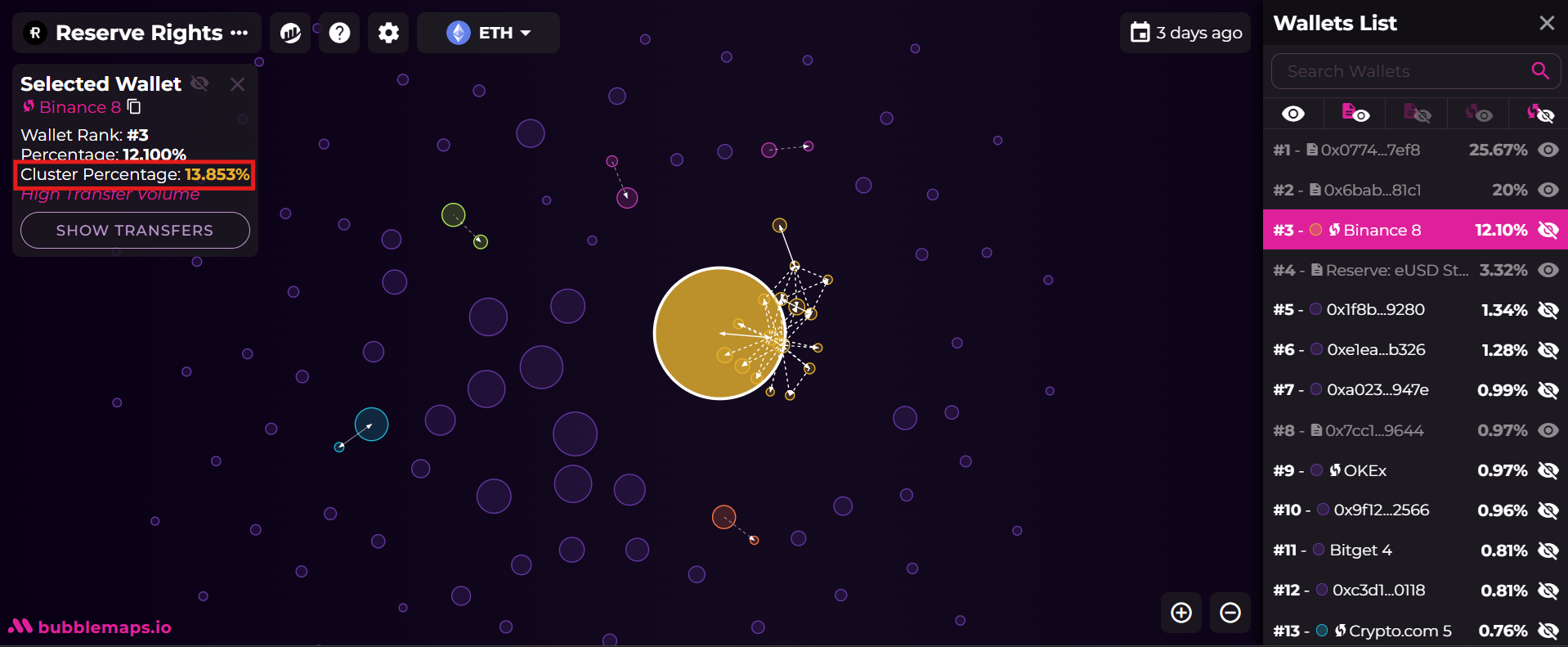
📌 Connections between wallets can mean several things:
✔️ A simple movement of funds between wallets belonging to the same user.
✔️ A transfer to or from an exchange platform (CEX or DEX).
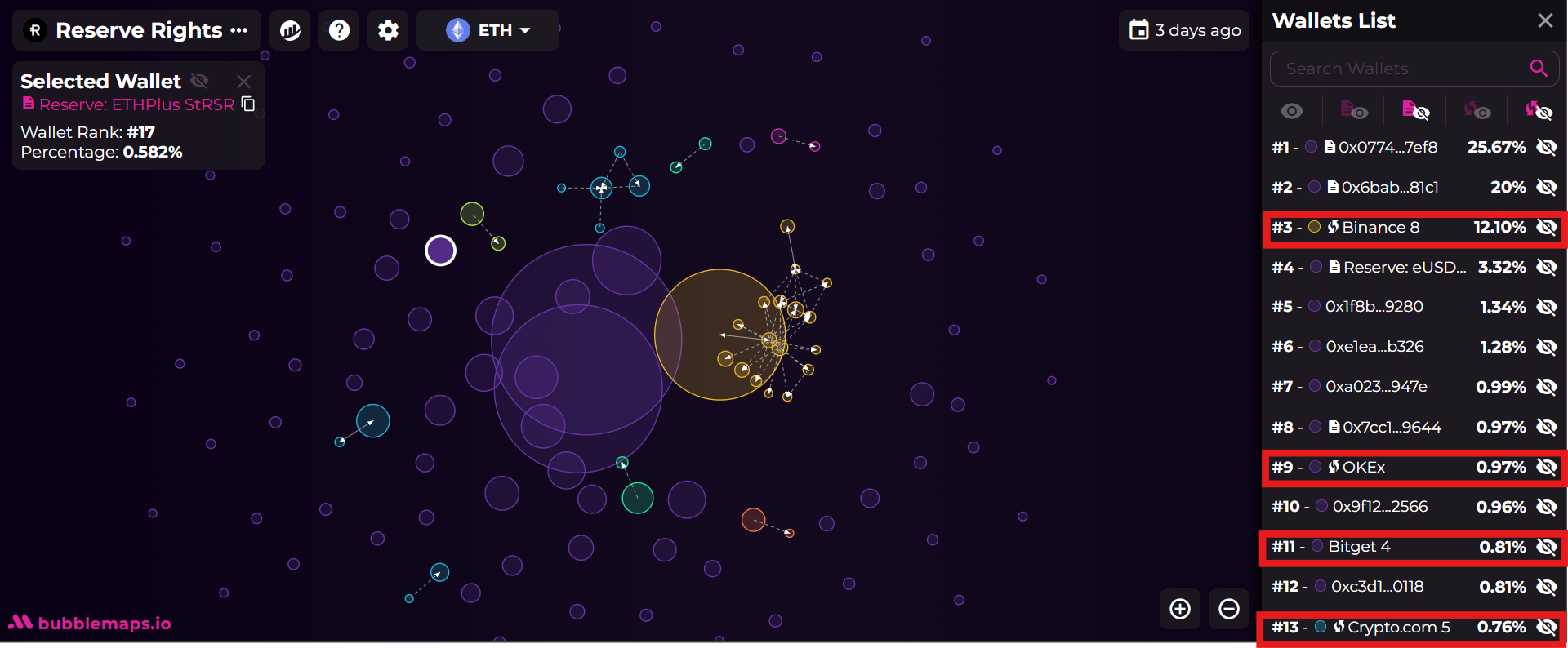
✔️ A Wash Trading diagram (see next section).
✔️ A planned distribution (team allocation, vesting , staking , etc.).
Bubblemaps offers two essential options to refine the analysis:
🔍 Show/Hide Contracts : Allows you to show or hide smart contract related vesting contracts , staking , or liquidity pools on DEXs.
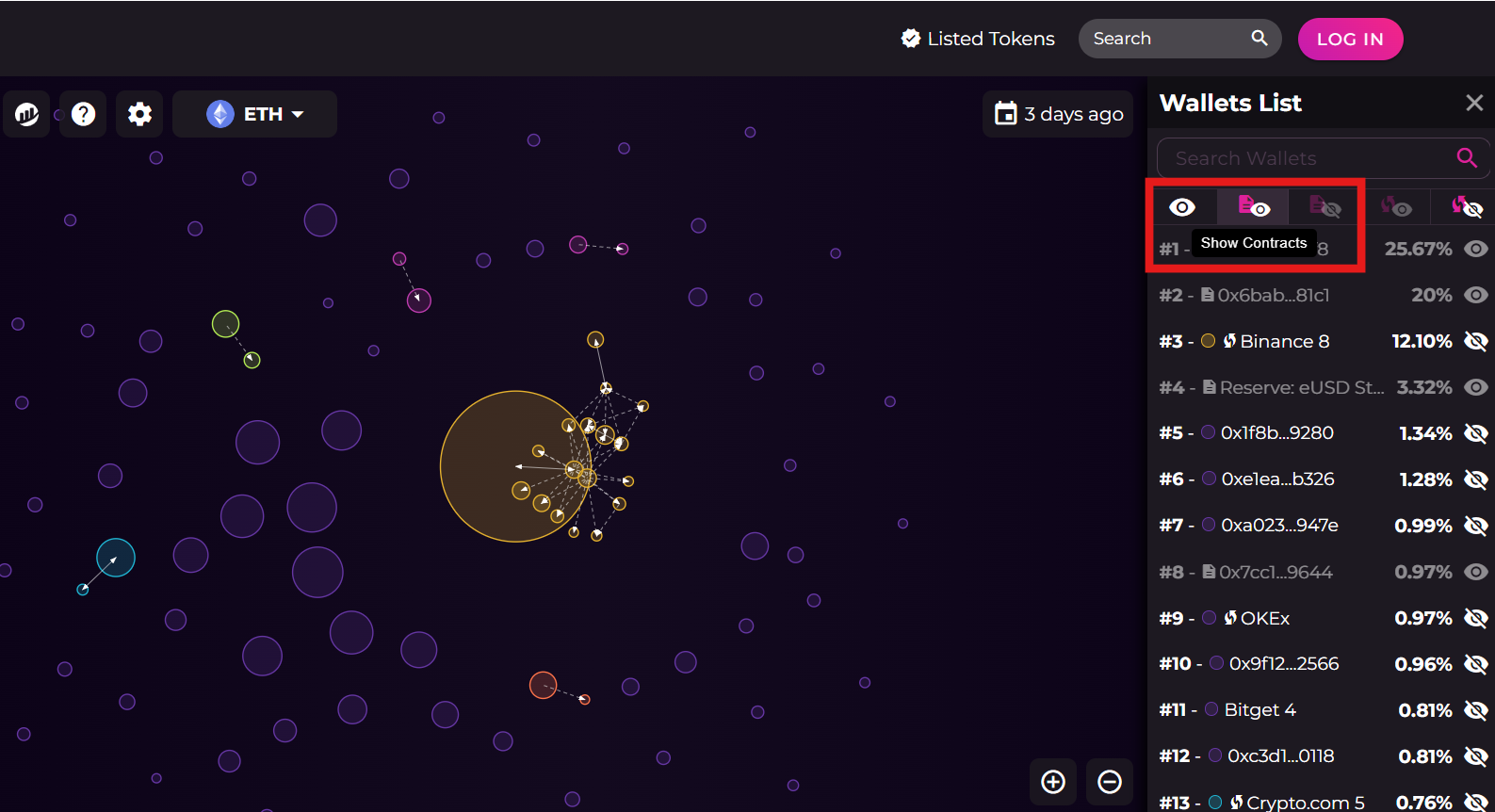
💱 Show/Hide Exchanges : mask or displays the wallets belonging to the centralized exchange platforms (CEX). These wallets are often used to store the liquidity of the tokens available on the markets. This option makes it possible to identify whether a large share of the offer is held on a CEX, which can influence the liquidity and volatility of the token.
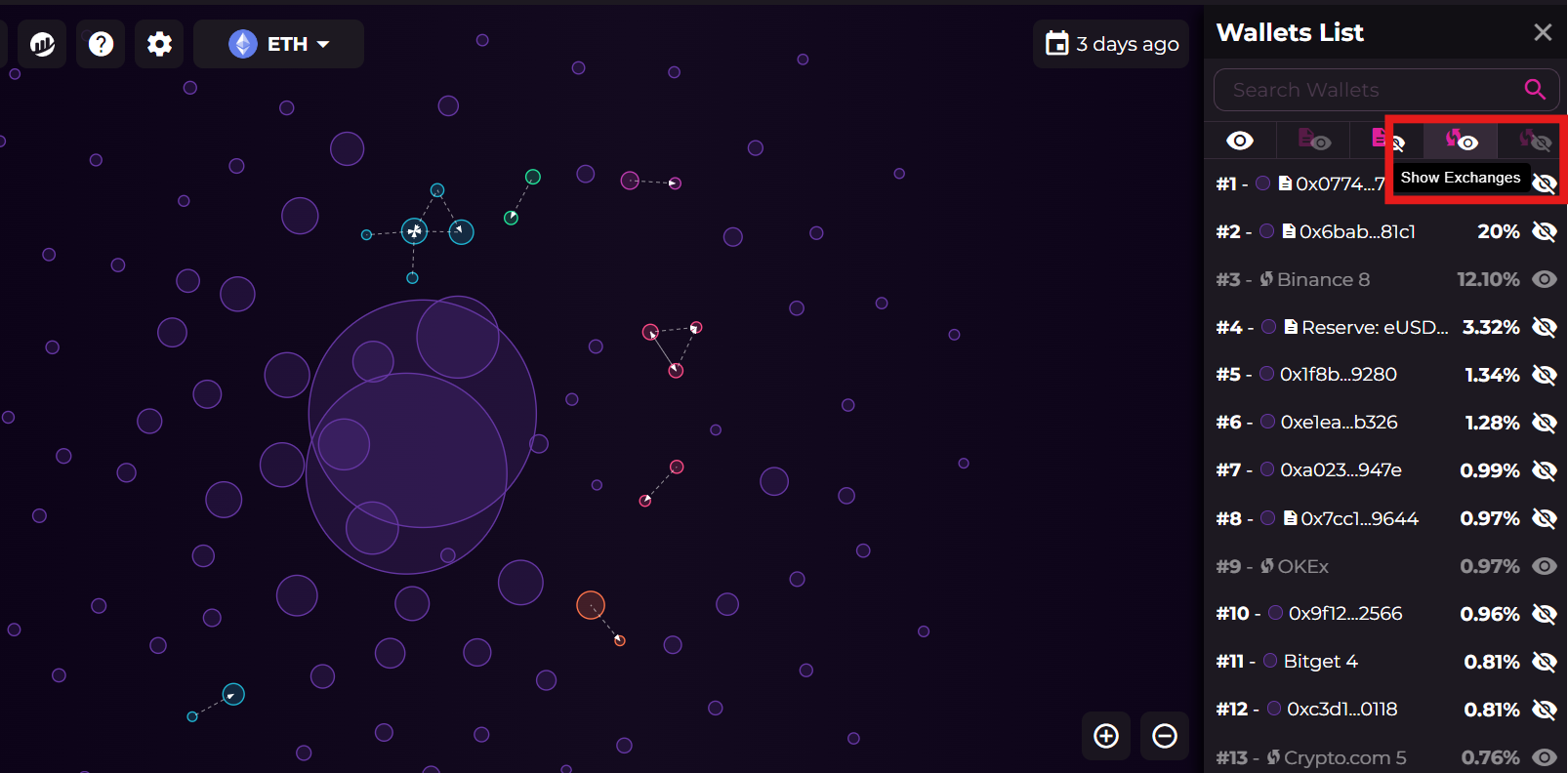
Wash trading: why inflate the volume is advantageous?
Wash Trading is a market manipulation practice where actors exchange assets with each other to simulate an important trading activity.
📌 Why do Wash Trading?
✔️ Create a false feeling of liquidity: by artificially increasing the exchange volume, this gives the illusion that the token is very active.
✔️ attract more investors: traders and algorithms often detect assets at high volume. A token with high activity is more likely to attract new buyers.
✔️ Improve the ranking on platforms: Exchanges and aggregators like CoinmarketCap often classify tokens according to their exchange volume. An efficient Wash Trading allows you to be better classified and more visible.
✔️ Facilitating acceptance on exchanges: a project with an artificially high volume may seem more attractive to centralized exchanges, which seek to list popular tokens.
📸 Detection on Bubblemaps :
a Wash Trading can be spotted by observing repetitive connections between a small group of wallets, where tokens systematically return to the same addresses without significant external transactions.
Identifying and Understanding Clusters
A cluster is a collection of wallets that frequently exchange tokens with each other. Cluster analysis can help you:
✔️ Determine token centralization.
✔️ Identify suspicious activity, such as coordinated sales.
✔️ Identify fund management by a team or DAO.
📌 Why is it important?
A very dense cluster controlled by the same entity may mean that the project is highly centralized.
A group of wallets with repetitive transfers can suggest Wash Trading, a technique to artificially inflate the exchange volume.
📸 Example: Some NFT projects such as squiggles have been exhibited for Wash Trading. They could be detected on Bubblemaps .

Why can a highly centralized project be problematic?
A project where a small handful of players hold a large part of the tokens can pose several risks for investors:
📌 High control power
if a single entity or a limited group holds a significant part of the Tokens, this gives them disproportionate power on the project. This may include:
✔️ Handling votes in decentralized governance (DAO).
✔️ The possibility of selling in mass and causing a krach.
✔️ An asymmetry of information where insiders benefit from an advantage on the rest of the market.
📌 Increased volatility and dump risk
If the team or early investors hold a majority of the tokens, this means that when their vesting expires, they can sell massively, causing a sharp drop in price.
📌 Low organic adoption
A too centralized token can lack active participation because the majority of tokens remain in the hands of a few actors. This can limit interest in the project and slow down its adoption.
Case study: Jupiter analysis (JUP) on Bubblemaps
After exploring the general functioning of Bubblemaps , we will illustrate its usefulness with a concrete case study: the analysis of Jupiter (JUP) , one of the major tokens of the Solana . This study will help us better understand how to interpret the data displayed and avoid interpretation errors linked to the distinction between the supply in circulation and the total offer.
What Bubblemaps shows about Jupiter
By selecting Jupiter (JUP) on Solana , Bubblemaps displays several wallet clusters who hold a significant part of the Tokens:
- The Cold and hot wallet S of the Jupiter hold about 45 % of tokens.
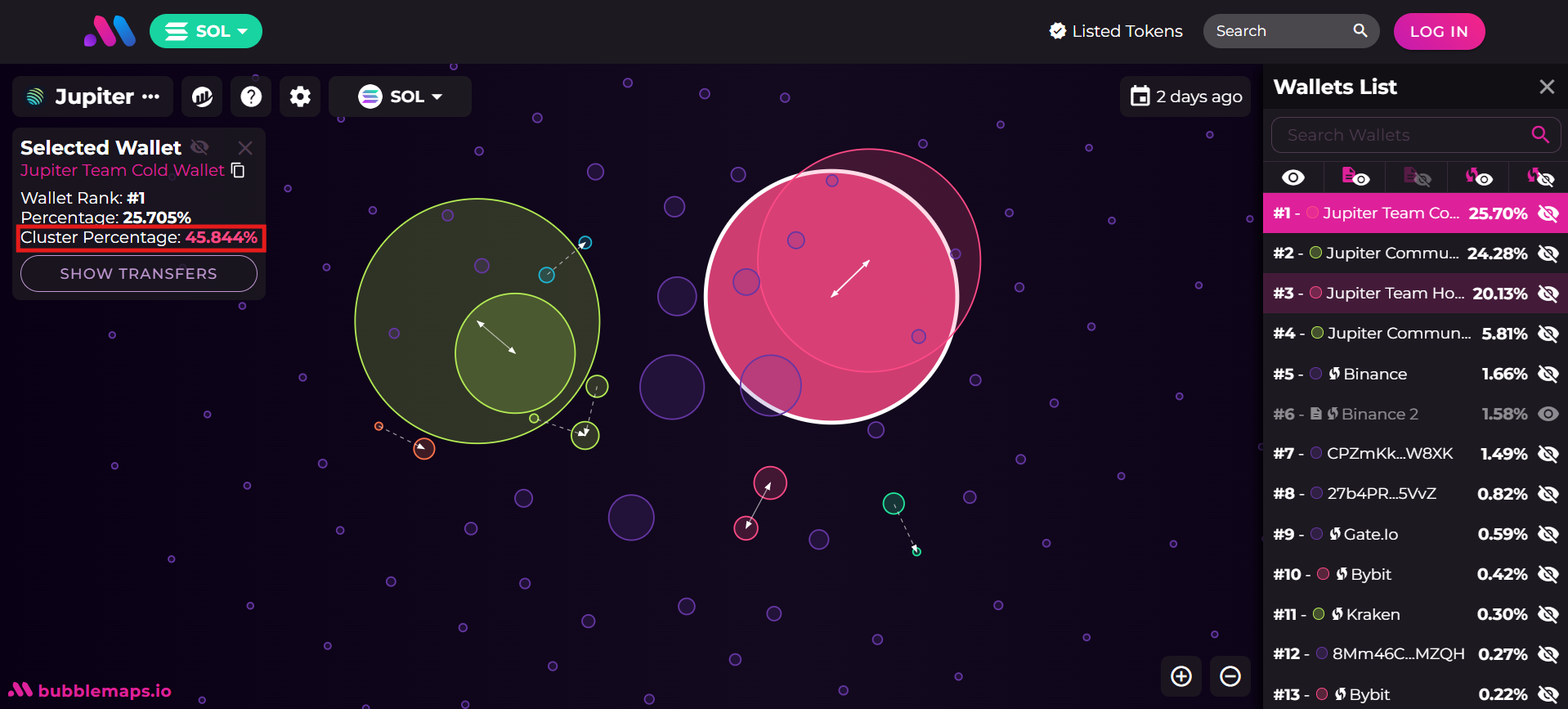
- The Hot and cold wallet S linked to the community controls around 30 % .
- Some centralized exchanges (CEX) such as Binance have approximately 1.66 % of the offer.
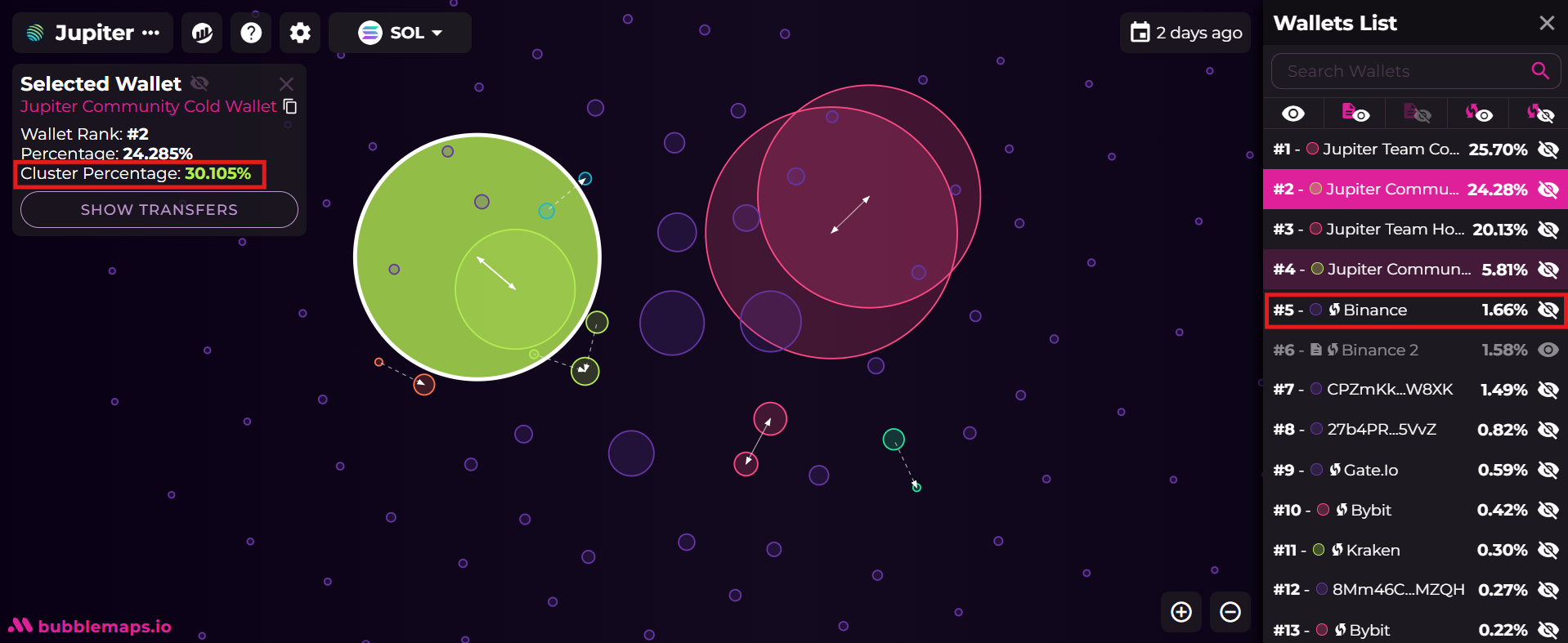
🔎 Interpretation problem detected :
These percentages are based on the total offer of JUP (7 billion tokens) and not on the supply in circulation. Currently, only 1.7 billion JUP are in circulation. This means that the majority of tokens visible on Bubblemaps are still locked and are not really available on the market.
➡️ Why is it important?
An investor who only considers the distribution of wallets on Bubblemaps might overestimate the token's true liquidity. Some tokens are locked in vesting contracts , strategic reserves , or community funds , preventing their immediate sale.
What is the community in a crypto project?
In cryptocurrencies, the community is a wide term that generally brings together users, investors and active contributors around the project. This may include:
- Protocol users (traders, developers, tokens holders).
- Participants in the DAO (decentralized governance).
- The members of the ecosystem benefiting from subsidies, incentives or Airdrops.
However, in many projects , community funds are actually under the control of the team or a small group, with a phased release following a vesting .
📌 In the case of Jupiter (JUP) , a large part of the tokens classified as “community funds” is still locked, which means that they are not really in the hands of individual investors, but rather reserved for future allowances.
Determine the real offer: crossing data with Arkham and Tokenomist
In order to obtain a more precise view of the real state of JUP's offer, we have encountered the data from Bubblemaps , Arkham and Tokenomist .
📌 Step 1: Verification of funds on Arkham
Arkham allows us to identify the Wallet of the Jupiter which holds 30 % of tokens on Bubblemaps . By consulting its balance, we find approximately 2.1 billion JUP .
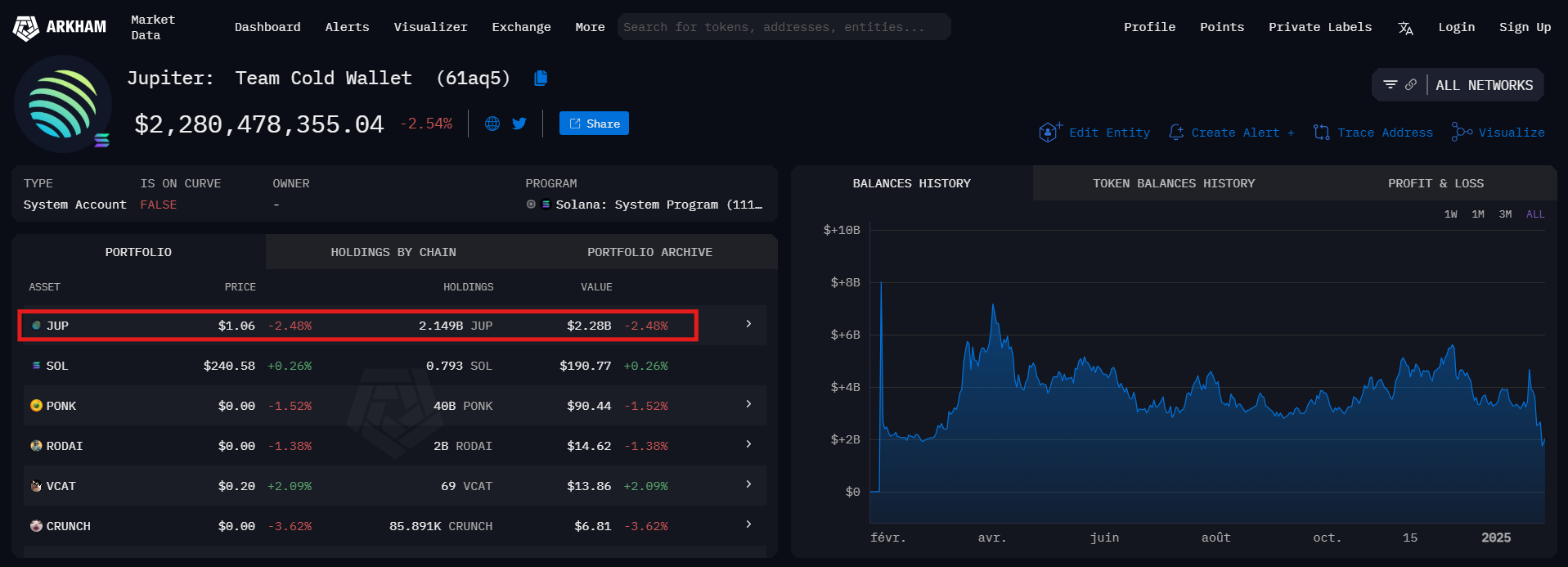
➡️ Interpretation :
this represents 30 % of the total offer of 7 billion JUP , which confirms that Bubblemaps Displays the total offer and not the supply in circulation .
📌 Step 2: Verification of the total offer and in circulation on Tokenomist
Tokenomist provides detailed information on token vesting
- 73 % of the total supply is still locked (or 5.09 billion JUP ).
- These tokens are distributed in different categories with periods of progressive release.
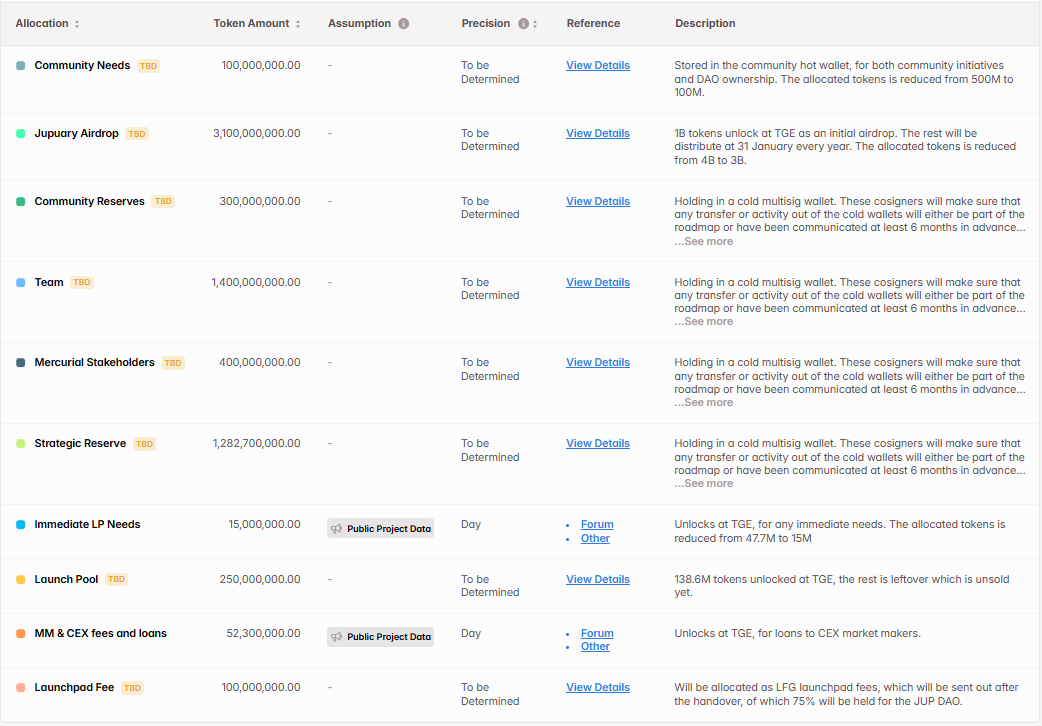
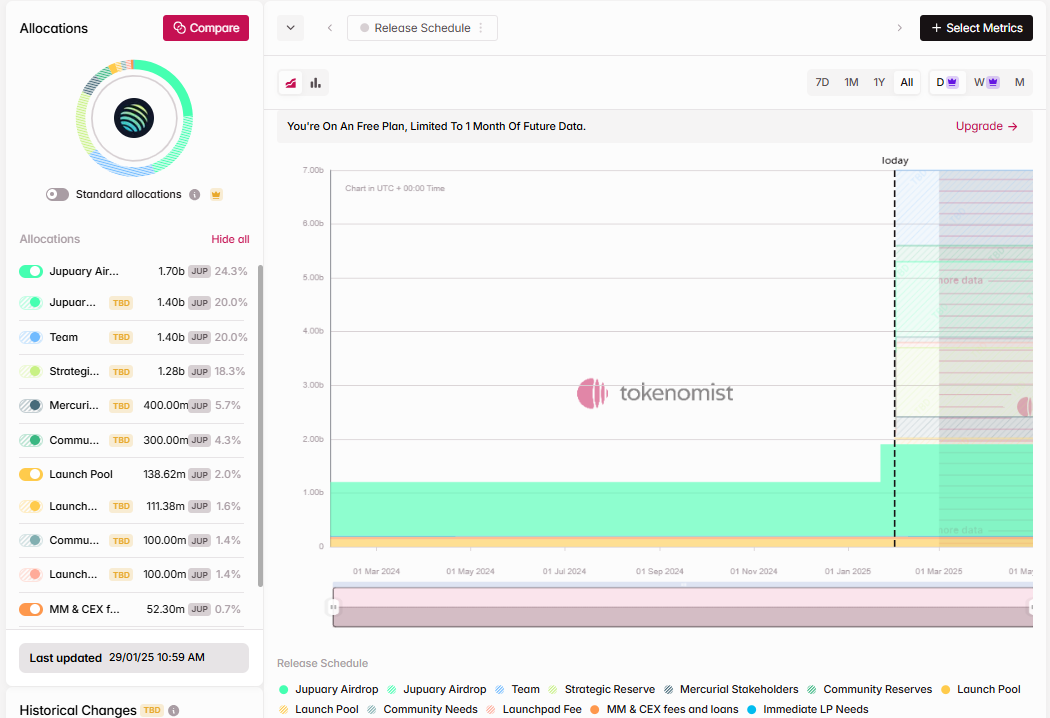
➡️ Conclusion:
the tokens visible on Bubblemaps include the still blocked tokens , which can give an erroneous impression of the real liquidity of the project if you do not cross the data.
Recommendation: always cross data
💡 Do not trust only the clusters displayed on Bubblemaps .
Before investing, it is essential to:
✔️ Verify the funds on Arkham to confirm wallet ownership.
✔️ Analyze the circulating supply on Tokenomist to avoid overestimating liquidity.
✔️ vesting periods to anticipate potential selling pressure.
✔️ Analyze transaction flows to detect potential market manipulation such as wash trading.
Comparison and implications for on-chain analysis
By crossing the data of the different tools, here is a more precise distribution of the total offer vs the supply in circulation and what each tool brings to the analysis:
| Tool | Main information |
|---|---|
| Bubblemaps | Visualize the distribution of wallets on the total , including the funds generally locked. |
| Tokenomist | Details the distribution of funds with precise categorization (team, community, strategic reserve). Confirm that 73 % of tokens are blocked without defined liberation calendar. |
| Arkham | Allows you to identify the entities behind the visible wallets on Bubblemaps (team, exchanges, DAOS, investors). Confirm that the address identified on Bubblemaps (30 % of tokens) corresponds well to the Jupiter . |
| Coinmarketcap (optional if tokenomist is available) | Indicates that only 1.7 billion JUP are in circulation , helping to avoid interpretation errors on the real liquidity of the market. |
📌 Implications for on-chain analysis:
✔️ Do not confuse the total supply with the circulating supply to avoid misjudging the token's actual liquidity.
✔️ Use Arkham to allocate wallets and avoid assuming that some funds are accessible when they belong to locked contracts. vesting
schedules on Tokenomist to anticipate potential selling pressure when locked funds are released.
✔️ Observe flows between team wallets and exchanges to detect potential strategic sales or a gradual redistribution of tokens in the market.
Conclusion on Bubblemaps
Bubblemaps is a relevant tool for visualizing the distribution of tokens and understanding how a project is structured.
It is also important to note that some tokens are compatible with several blockchains. Thus, a complete analysis can only be carried out by exploring the distribution of the token on all the compatible blockchains of the token.
For a real understanding of the distribution of tokens, it is essential to cross your analyzes with other platforms such as Tokenomist and Arkham in order to avoid interpretation errors on the actually available offer.
✅ A project may seem very centralized while its funds are locked, or vice versa.
✅ A wise investor must always analyze real liquidity and the periods of liberation of tokens.
Investments in cryptocurrencies are risky. Crypternon could not be held responsible, directly or indirectly, for any damage or loss caused following the use of a property or service put forward in this article. Readers must do their own research before undertaking any action and investing only within the limits of their financial capacities. Past performance does not guarantee future results. This article does not constitute an investment .
Certain links of this article are affiliated, which means that if you buy a product or register via these links, we will collect a commission from our partner. These commissions do not train any additional cost for you as a user and certain partnerships allow you to access promotions.
AMF recommendations. There is no guaranteed high yield, a product with high performance potential implies a high risk. This risk taking must be in line with your project, your investment horizon and your ability to lose part of this savings. Do not invest if you are not ready to lose all or part of your capital .
To go further, read our pages legal notices , privacy policy and general conditions of use .

